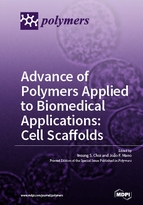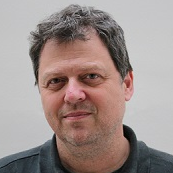Advance of Polymers Applied to Biomedical Applications: Cell Scaffolds
A special issue of Polymers (ISSN 2073-4360).
Deadline for manuscript submissions: closed (30 June 2017) | Viewed by 150867
Special Issue Editors
Interests: cell-surface engineering; cell-material interfaces; biomimetic chemistry
Interests: biomaterials; tissue engineering; 3D in vitro models; controlled delivery of bioactive molecules; nature-based biodegradable polymers; biomimetic and nano/micro-technology approaches
Special Issues, Collections and Topics in MDPI journals
Special Issue Information
Dear Colleagues,
Cells in vivo sense and respond to signals from the outside environment (e.g., other cells and extracellular matrices) for their orchestrated behavior and function. The signals come in and out in various forms, including biochemical, electrochemical, structural, and mechanical signals. Since the pioneering work by Langer and Vacanti, in vitro mimicry of the juxtacrine interactions has been achieved mainly through the use of polymers in regenerative medicine and cell therapy. The polymers act as 3D or semi-3D scaffolds for cells, on which the cells grow and proliferate.
The primary function of polymeric scaffolds was initially structural, providing the physical sites for cell adhesion and growth in a 3D form. However, scientific and technological developments have advanced to enable the manipulation of cell behavior and function, ultimately controlling cell fate, by the use of polymers, including supramolecular hydrogels. For example, as a cell scaffold, mucin-mimetic synthetic diblock copolymers have the capacity to hold human pluripotent stem cells in the quiescent G0 state in vitro, while maintaining their viability and pluripotency; Polymeric surfaces with specific topographical and chemical features direct stem cell differentiation and spacial organization; Pericellular hydrogels inhibit only cancer cells by cancer cell-specific enzymatic reactions; Individual cells are coated with polymers, and 3D cellular aggregates are formed in a controlled manner by biospecific interactions; Enzymatic reactions are utilized for the in situ formation of polymeric sheaths on cells; Microfluidic fabrication is used for programmed cell immobilization in the polymer scaffolds; And polymer-based cell-surface engineering is used for controlling cellular activities at the single-cell level. Technological advances, such as the development of 3D bioprinting, also allow for the fabrication of cellular hybrid devices wtih high geometrical control of cell positioning, including hierarchically organized scaffolds and multicell-polymer structures.
The purpose of this Special Issue is to highlight the recent achievements in the use of polymers as cell scaffolds on a broad scale, not only limited to the use of polymers as cell-culture scaffolds, but also including polymer-based approaches for controlling interfacial interactions of cells in vitro.
Prof. Dr. Insung S. Choi
Prof. Dr. João F. Mano
Guest Editors
Manuscript Submission Information
Manuscripts should be submitted online at www.mdpi.com by registering and logging in to this website. Once you are registered, click here to go to the submission form. Manuscripts can be submitted until the deadline. All submissions that pass pre-check are peer-reviewed. Accepted papers will be published continuously in the journal (as soon as accepted) and will be listed together on the special issue website. Research articles, review articles as well as short communications are invited. For planned papers, a title and short abstract (about 100 words) can be sent to the Editorial Office for announcement on this website.
Submitted manuscripts should not have been published previously, nor be under consideration for publication elsewhere (except conference proceedings papers). All manuscripts are thoroughly refereed through a single-blind peer-review process. A guide for authors and other relevant information for submission of manuscripts is available on the Instructions for Authors page. Polymers is an international peer-reviewed open access semimonthly journal published by MDPI.
Please visit the Instructions for Authors page before submitting a manuscript. The Article Processing Charge (APC) for publication in this open access journal is 2700 CHF (Swiss Francs). Submitted papers should be well formatted and use good English. Authors may use MDPI's English editing service prior to publication or during author revisions.
Keywords
- polymer scaffolds
- biomaterials
- cell-surface engineering
- biodegradable polymers
- hydrogels
- biomimetic substrates








